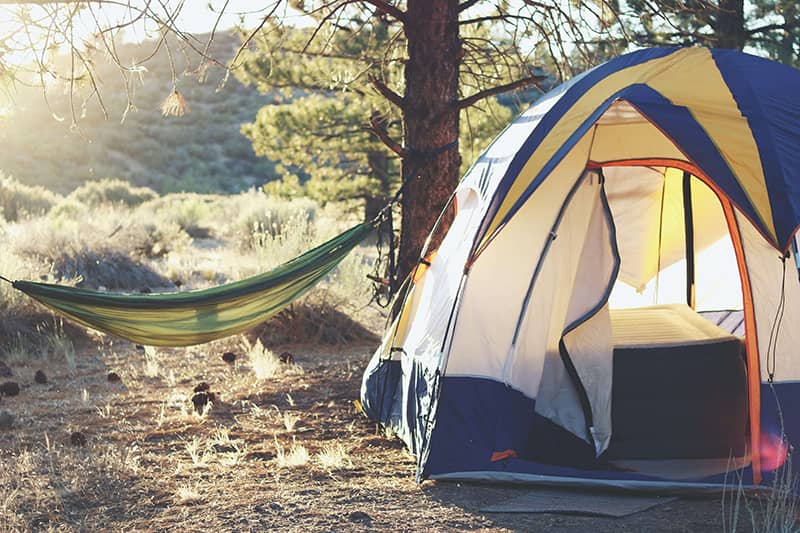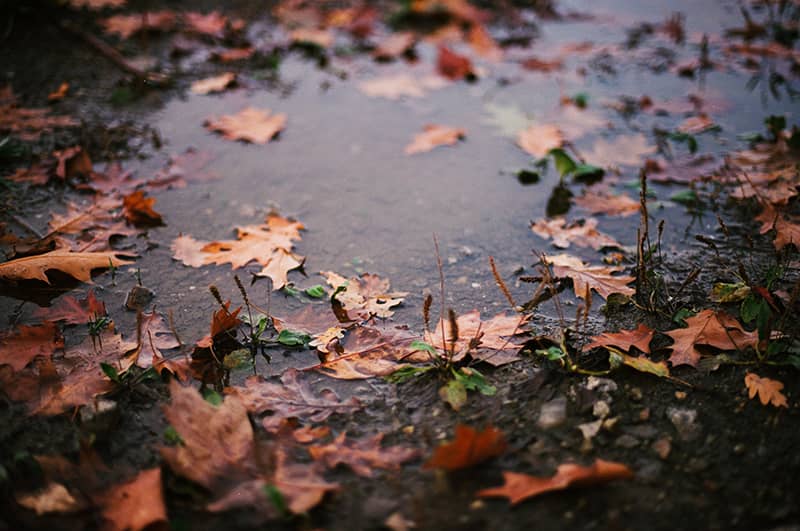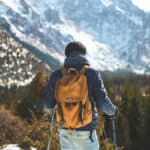Camping Hacks: Creative and Time-Saving Ways to Set Up Your Campsite
This is a blog post that provides readers with useful tips and tricks for making setting up a campsite easier and more efficient. The post covers various topics, including choosing the right campsite, packing smartly, and quickly and effectively setting up camp.
It also includes some creative and innovative camping ideas, such as using a pool noodle to keep your tent stakes organized or a headlamp as a lantern. Overall, this blog post is a valuable resource for anyone looking to make their next camping trip more enjoyable and stress-free.
Camping hacks are innovative and time-saving strategies and techniques that campers can employ to simplify and enhance their camping experience. These hacks can range from simple suggestions for more efficient gear packing to more complex solutions for setting up your campsite.
Camping hacks aim to make camping more enjoyable, and less stressful.
Knowing camping hacks can be especially beneficial for beginners who are new to camping and may not have much outdoor experience. Even experienced campers can benefit from learning new camping hacks and tricks to make their trips more efficient, comfortable, and enjoyable.
Camping hacks allow you to spend less time setting up and more time enjoying the great outdoors.

Why do you need to know about creative and time-saving ways to set up your campsite?
- It makes camping more fun and less stressful. Simplifying setup lets campers relax and appreciate nature. This can improve the experience and increase nature appreciation.
- Safety depends on knowing new, time-saving campsite setup methods. A good setup helps prevent camping equipment accidents. Campers can better handle unexpected weather and other problems by being well-prepared and knowing how to rapidly set up camp.
- Ultimately, camping hacks save money over time. Reusing or inventing camping gear saves money. Camping is more affordable and environmentally friendly for individuals on a budget. Successful camping requires inventive and time-saving campground setup strategies.
After understanding the importance of choosing a camp, let’s introduce how to choose a campsite.
Selecting the Right Campsite
It’s crucial to take into account aspects like closeness to water sources, topography, and flat ground for your tent while choosing a campsite. Also, spending some time learning about the region and reading reviews from other campers may offer insightful information and guide you away from typical blunders when selecting a campground.
Factors to consider when choosing a campsite
A successful camping trip begins with selecting the right campsite. When choosing a campsite, several factors must be considered, including location, terrain, and proximity to amenities.
- First, location. Whether they choose an isolated wilderness area or a developed campground with facilities, campers should choose a spot that suits them. Transportation should be easy in the area.
- Terrain matters too. Campers should consider how the terrain will affect their setup. Pitch a tent or build a campfire on rough or uneven ground. Low-lying areas may also flood or get wet.
- Campsite amenities should also be considered. Amenities include bathrooms, showers, and water. Depending on your comfort and experience, you may need different conveniences to enjoy camping.
- While choosing a campsite, consider wildlife, firewood, and local laws. These characteristics can help campers find a campsite that matches their needs and provides a safe and fun outdoor experience.
Tips for finding the best spot for your needs
Finding the best spot for your needs is critical for a comfortable and enjoyable camping experience. Here are some pointers to help you find the ideal campsite:
- LOOK FOR LEVEL GROUND: To ensure a comfortable sleeping surface and ease of setting up camp, the ground should be flat and even.
- EXAMINE THE TERRAIN: Look for a location with the soft ground for easy tent pitching and stake anchoring.
- CONSIDER PROXIMITY TO WATER: If you’re camping in an area without potable water, look for a site near a water source, such as a river or stream, but make sure the water is safe to drink.
- CONSIDER SUN EXPOSURE: Depending on the time of year and the climate, you may prefer a location with some shade or sun exposure.
- CHOOSE A SITE WITH MORE PRIVACY if you prefer a quieter, more secluded camping experience.
- CHECK FOR WIND EXPOSURE: Select a site that is wind-sheltered to avoid being blasted by strong gusts that could make camping uncomfortable.
By taking these factors into account, you can find the best location for your needs and have a comfortable and enjoyable camping experience.
How to avoid common mistakes
Camping can be a fun and rewarding experience, but it’s critical to avoid common blunders that can turn a good trip into a disaster. Here are some tips for avoiding common camping mistakes:
- OVERPACKING: Only bring what you need and avoid overpacking. Bringing too much gear can make setting up camp more difficult and create unnecessary clutter.
- NOT CHECKING THE WEATHER: Before leaving the house, check the weather forecast to avoid being caught off guard by unexpected weather conditions.
- SETTING UP CAMP IN THE WRONG PLACE: Choose a campsite that meets your needs and preferences.
- NOT ADHERING TO LEAVE NO TRACE PRINCIPLES: Respect the environment and adhere to Leave No Trace principles by packing out all trash and minimizing your impact on the environment.
- FORGETTING ESSENTIAL ITEMS: Make a checklist of essential items and double-check it before leaving to ensure you haven’t forgotten anything.
- STARTING A CAMPFIRE IN HAZARDOUS CONDITIONS: Obey local regulations and avoid starting a campfire in windy or dry conditions.
You can have a safe and enjoyable camping experience if you are prepared and avoid these common mistakes.
The next step after choosing a campsite is to prepare the items needed for camping and it is essential to pack smart.

Packing Smart
When packing for a camping trip, it’s important to bring essential gear such as a tent, sleeping bag, and cooking supplies. To pack efficiently and save space, consider using storage containers, packing cubes, or compression bags, and creating a camping checklist can help ensure you don’t forget anything important.
Essential gear to pack for your camping trip
Packing the right camping gear is critical for a comfortable and safe camping trip. Here are some must-have items for your camping trip:
- Tent: A high-quality tent is a must-have for any camping trip. Make sure to choose a tent that suits your needs and can accommodate the number of people you’re camping with.
- Sleeping Bag and Pad: A good sleeping bag and pad will keep you warm and comfortable throughout the night.
- Camp Stove and Fuel: A portable stove and fuel will enable you to cook hot meals and boil water for drinking.
- Headlamp or Flashlight: A headlamp or flashlight is essential for navigating in the dark.
- First Aid Kit: A well-stocked first aid kit can aid in the treatment of minor injuries and illnesses.
- Water Filter or Purification Tablets: Pack a water filter or purification tablet to ensure access to safe drinking water.
- Multi-Tool: A multi-tool can be useful for a variety of tasks, from opening cans to repairing gear.
- Navigation Tools: Bring a map, compass, and/or GPS device to help you navigate through unfamiliar terrain.
- Warm Clothing and Rain Gear: Be prepared for changes in weather by packing warm clothing and rain gear.
You’ll be well-prepared for a safe and comfortable camping trip if you pack these essential items.
Creative ways to pack efficiently and save space
Packing efficiently and saving space is essential when planning a camping trip, especially if you have limited storage space. Here are some inventive methods for packing efficiently and saving space:
- USE COMPRESSION BAGS: Compression bags are a great way to pack clothing and bedding tightly and save space.
- USE LIGHTWEIGHT AND COLLAPSIBLE GEAR: To save space, look for lightweight and collapsible gear, such as folding chairs and tables.
- UTILIZE REUSABLE CONTAINERS: Bring reusable containers, such as Tupperware, to store food in order to reduce the amount of packaging you bring.
- ROLL CLOTHING RATHER THAN FOLD IT: Rolling clothing rather than folding it can help save space and prevent wrinkles.
- PACK ITEMS INSIDE OTHER ITEMS: Use the space inside larger items, such as coolers, to store smaller items and maximize space.
- Use packing cubes: Packing cubes can help you organize your gear and make it easier to find what you need.
- BRING MULTI-USE ITEMS: Bring items that can serve multiple functions, such as a bandana that can be used as a towel or a pot holder.
You can save space and pack efficiently by using these inventive packing strategies, making your camping trip more enjoyable and stress-free.
How to make a camping checklist to ensure you don’t forget anything
Making a camping checklist is an important step in making sure you don’t forget anything important for your trip. Here’s how to create a thorough camping checklist:
- Begin with the fundamentals: Begin by making a list of the necessities, such as a tent, sleeping bag, and cooking supplies.
- Consider the following activities: Consider the activities you intend to participate in, such as hiking or fishing, and ensure you have the necessary equipment.
- Check the weather: Check the weather forecast and pack accordingly, including warm clothing and rain gear if needed.
- Consider food and water: Plan your meals and bring enough food and cooking supplies. Also, consider bringing a water filter or purification tablets to ensure access to clean drinking water.
- Don’t forget personal items: Remember to pack personal items such as toiletries, medication, and sunscreen.
- Consider the location: If you’re camping in a remote area, bring extra supplies and equipment, such as a satellite phone or an emergency beacon.
- Check your gear before leaving: Before leaving, check your gear to ensure that everything is in working order.
By following these steps and creating a comprehensive checklist, you can ensure that you don’t forget anything important for your camping trip.
Setting Up Camp Quickly and Effectively
Pitching a tent can be frustrating and time-consuming, but with some tips and tricks, it can be done quickly and easily.
A level, sheltered spot with a natural windbreak like trees or bushes is ideal for your tent. Clear the area of rocks, branches, and other debris that could damage or bother the tent.
Before starting, lay out all tent parts and read the instructions. This can speed up setup and reduce errors. Assigning roles to each group member can also speed up the process.
In windy conditions, bring a hammer or mallet to secure tent stakes and extra stakes and guylines. Finally, double-check your tent’s pitch and guying before leaving it.
These tips will help you pitch your tent quickly and spend more time outdoors.
By providing convenience and comfort throughout your stay, organizing your campsite can make a significant difference in your overall camping experience.
- Start by establishing cooking, sleeping, and relaxing areas with the necessary gear. Store food, trash, and other items in bear-resistant canisters to keep your campsite tidy.
- Bring a camping table or collapsible storage containers for cooking and organizing. Lanterns, utensils, and towels on hooks or carabiners save space and make things accessible.
- When planning a campsite, consider your personal preferences. A sleeping pad or air mattress may help you sleep on hard ground. Bring a camp chair or hammock for evening reading or games.
Overall, by taking the time to thoughtfully organize your campsite, you can create a comfortable and enjoyable home away from home in the great outdoors.
Tricks for setting up camp in the dark or bad weather
Setting up camp can be challenging enough in ideal conditions, but in the dark or bad weather, it can be even more difficult.
However, with a few tricks up your sleeve, you can make the process more manageable.
Firstly, it’s important to choose a suitable location for your campsite, with natural windbreaks and sheltered areas that can protect your tent from the elements. It’s also a good idea to clear the area of any debris that could cause discomfort or damage your gear.
When setting up in the dark, it’s helpful to use a headlamp or lantern to light your way, and to lay out all of your gear and equipment in a logical order beforehand. Assigning specific tasks to each member of your group can also help streamline the process and prevent confusion.
In bad weather, it’s crucial to prioritize keeping yourself and your gear dry. Consider setting up a tarp or rainfly over your tent, and packing extra towels or clothing to dry off in case of getting wet. Utilizing a waterproof stuff sack for your sleeping bag can also help ensure that you stay warm and dry throughout the night.
By using these tricks and being prepared for challenging conditions, you can set up camp in dark or bad weather with greater ease and confidence.

Creative Camping Hacks
Innovative methods can make camping more fun and comfortable. Camping comfort depends on sleeping arrangements.
Sleeping pads, bags, and blankets can help you sleep well. Earplugs and eye masks can also block noise and light for a more restful sleep. Bringing home comforts can also improve camping.
Camping hacks improve comfort and enjoyment. Creative camping hacks can solve common camping issues like keeping tent stakes in the ground or finding a light source in the dark.
Pool noodles can replace tent stakes. Strap a headlamp to a water bottle or gallon jug to make a lantern. This diffuses light and provides water for your trip.
Other camping hacks involve reusing everyday items. You can use a muffin tin to cook multiple dishes over a campfire or a shower cap to keep your shoes dry in a campground bathroom.
These creative ideas can make your camping trip more comfortable, enjoyable, and convenient without sacrificing nature’s beauty. Keep safety and common sense in mind when using these camping hacks.
Test new hacks before using them and be aware of the risks of unconventional camping.
Conclusion
While unconventional camping hacks can be entertaining and creative, it is critical to prioritize safety when employing them. Here are some precautions to take:
- Use common sense: Don’t use a camping hack if it seems unsafe or unreliable.
- Test it out first: Before relying on a camping hack, make sure it works and is safe at home.
- Follow the manufacturer’s instructions: If you’re going to use your gear in an unusual way, make sure to follow the manufacturer’s instructions for safe use.
- Don’t put safety ahead of convenience: While taking shortcuts may be tempting, prioritize safety over convenience.
- Keep emergency supplies on hand: Always have a first aid kit, emergency supplies, and a way to call for help on hand in case of an emergency.
- Be mindful of fire safety: When attempting unconventional hacks involving fire or flammable materials, exercise extreme caution and adhere to fire safety guidelines.
In conclusion, camping hacks are innovative and time-saving ways to improve your camping experience. You can make your camping trip more convenient, comfortable, and enjoyable by utilizing camping hacks.
Camping hacks can help you save time and effort while learning new skills, from finding the best campsite to packing efficiently, pitching your tent quickly, and organizing your campsite.
Furthermore, by being aware of safety precautions when employing unconventional camping hacks, you can ensure a safe and stress-free camping experience.
Overall, knowing and employing camping hacks can make a significant difference in your camping trip, allowing you to make the most of your time in nature.
A successful camping trip is all about being prepared and flexible. Here are some final tips to help ensure your trip goes smoothly:
- Leave No Trace: It’s essential to respect the environment and leave your campsite as you found it. Make sure to pack out all of your trash and dispose of it properly.
- Be Prepared for Weather Changes: Always check the weather forecast before leaving for your trip, but also be prepared for sudden changes in weather. Bring rain gear, warm clothes, and extra blankets just in case.
- Keep Emergency Supplies on Hand: Always have a first-aid kit and emergency supplies such as a whistle, matches, and a flashlight with fresh batteries.
- Embrace the Outdoors: Disconnect from technology and enjoy nature. Spend time hiking, exploring, and soaking in the beauty of your surroundings.
- Have Fun and Be Flexible: Remember that things don’t always go as planned, and that’s okay. Embrace the adventure and be flexible with your plans.
By following these final tips, you’ll be well-prepared for your camping trip and able to fully enjoy your time in the great outdoors. Now, get started on a well-planned camping trip!
